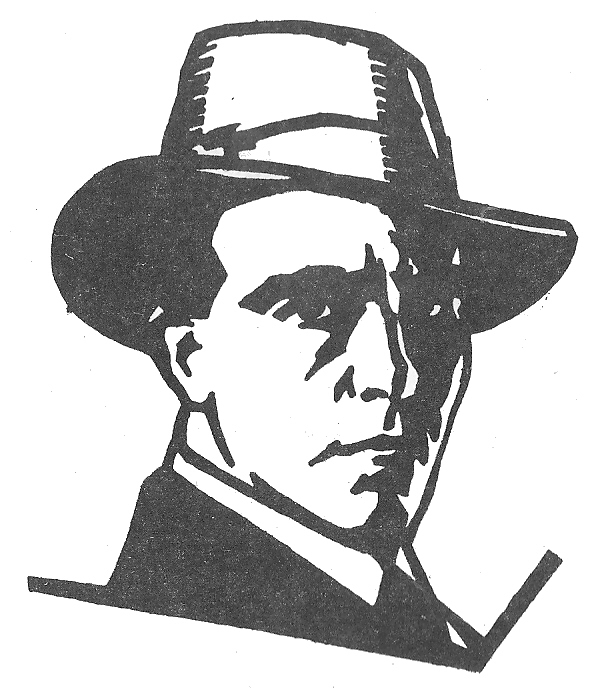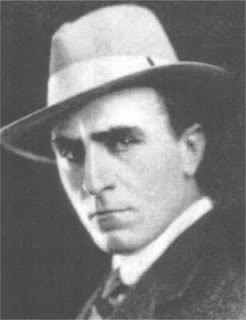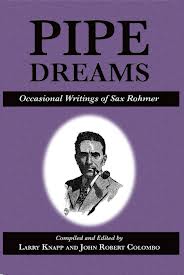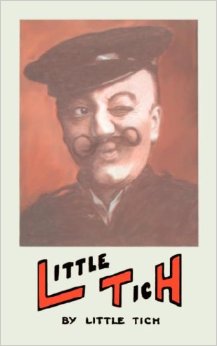Blogging Sax Rohmer… In the Beginning, Part Four

 We already noted in our last installment that Arthur Henry Ward had adopted the pseudonym of Sax Rohmer for his relatively successful career as a music hall songwriter and comedy sketch writer. He would later claim that he worked as a newspaper reporter during these years, but that his articles were published anonymously. Allegedly he covered waterfront crime in Limehouse, but he also claimed to have successfully managed interviews with heads of state. There is little doubt the man was a great raconteur, but none of the anonymously published articles and interviews Rohmer credits himself with writing have ever been located by researchers. It is highly questionable whether he ever actually worked as a journalist or at least to the extent he claimed. What is factual is that he did begin having works published anonymously.
We already noted in our last installment that Arthur Henry Ward had adopted the pseudonym of Sax Rohmer for his relatively successful career as a music hall songwriter and comedy sketch writer. He would later claim that he worked as a newspaper reporter during these years, but that his articles were published anonymously. Allegedly he covered waterfront crime in Limehouse, but he also claimed to have successfully managed interviews with heads of state. There is little doubt the man was a great raconteur, but none of the anonymously published articles and interviews Rohmer credits himself with writing have ever been located by researchers. It is highly questionable whether he ever actually worked as a journalist or at least to the extent he claimed. What is factual is that he did begin having works published anonymously.
As a young man, he ran with a crowd of self-styled bohemians who occupied a clubhouse on Oakmead Road in London. Each member of the gang was known by rather fanciful nicknames with Rohmer being known as Digger. Their activities ran from simply hanging around the clubhouse to picking up girls and attempting various get-rich-quick schemes to avoid making an honest living. Some of their schemes were of questionable legality.
Around this time, Rohmer decided he would fictionalize their exploits. It is believed he authored seven stories about the Oakmead Road Gang. Five manuscripts were known to have survived their author’s death: “Narky,” “Rupert,” “Digger’s Aunt,” “The Pot Hunters,” and “The Treasure Chest.” All seven stories were submitted for anonymous publication to Yes and No. It appears only the first of the group of stories ever saw print. The surviving four manuscripts passed upon the death of Rohmer’s widow to Cay Van Ash. When Van Ash died in Paris twenty years ago, Rohmer’s unpublished manuscripts were being held by a friend in Tokyo (where Van Ash lived for many years while teaching at Waseda University). When the friend had his visa rescinded on short notice in 2000, he was forced to leave his belongings behind, where they were junked by a Japanese family who thought the storage boxes contained worthless garbage.
“Narky” was published anonymously in Yes and No in June 1910. While the remainder of the series appears to have eluded publication, “Narky” proved surprisingly popular. The story was first collected in Masterpiece Library of Short Stories in 1923 (with authorship now credited to Sax Rohmer) and was reprinted in The Book of Laughter in 1935 and in Ellery Queen Mystery Magazine in February 1953. It appears that the story was initially considered humorous, despite the later publication in Ellery Queen. It is both a Cockney dialect humor piece as well as a very light-hearted crime story concerning Narky’s ill-fated attempt to become a thief.
 While Rohmer’s agent kept the story in print, the author chose not to include it in any of his collections of short fiction. Most telling is the fact that none of the unpublished manuscripts were cannibalized for his memoirs, Pipe Dreams (which he worked on throughout the 1930s) or for his widow’s highly anecdotal biography of her late husband, Master of Villainy (finally completed with the aid of Cay Van Ash and editor Robert E. Briney for publication in 1972). Interestingly, Digger was also the nickname by which the narrator of The Crime Magnet stories was known. It is left entirely up to the reader to decide whether the two characters are intended to be one and the same. It would appear Rohmer’s own sense of his efforts as a writer of humorous fiction was mixed.
While Rohmer’s agent kept the story in print, the author chose not to include it in any of his collections of short fiction. Most telling is the fact that none of the unpublished manuscripts were cannibalized for his memoirs, Pipe Dreams (which he worked on throughout the 1930s) or for his widow’s highly anecdotal biography of her late husband, Master of Villainy (finally completed with the aid of Cay Van Ash and editor Robert E. Briney for publication in 1972). Interestingly, Digger was also the nickname by which the narrator of The Crime Magnet stories was known. It is left entirely up to the reader to decide whether the two characters are intended to be one and the same. It would appear Rohmer’s own sense of his efforts as a writer of humorous fiction was mixed.
Greening and Co. was a short-lived British publishing house best remembered as the first to publish Baroness Orczy’s Scarlet Pimpernel novels. They also provided Rohmer with the chance to author two books anonymously in 1910 and 1911. Both book deals were dependent on Rohmer’s music hall contacts. George Robey was responsible for initiating the contract for the rather curious collection of short fiction and essays known as Pause! Robey likely had no hand in shaping the contents after initiating the contract as a favor to Rohmer, although allegedly the title and cover design were his concepts.
An extremely scarce volume, copies are held by at least two prominent collectors, but neither is willing to republish the material at present for fear of having the piece’s value diminish once it was reprinted. Happily, antiquarian collector George Vanderburgh managed to obtain a copy of two stories, “Sebek-Ra” and “The Bronze Mirror” from Pause! He included them as part of the first book publication of Rohmer’s serialized memoirs, Pipe Dreams, for publication by his Battered Silicon Dispatch Box imprint in 2012.
“Sebek-Ra” is the finest piece of writing Rohmer had yet produced. Curiously, the Egyptian god of crocodiles is never once referenced within the text, which concerns occult specialist, Dr. Slade Antiman, and his unhappy marriage to celebrated stage actress Sybil Hardeane. As with “Narky,” we have another portrait of an unhappy marriage and how the unconventional habits of the husband threaten their marriage (Narky’s dedication to the Oakmead Road Gang and his decision to pursue a life of crime and Antiman’s growing obsession with the occult at the exclusion of all others – consider his surname).
In the case of Dr. Antiman, his marriage was part of an elaborate occult experiment involving crystal-gazing and astral projection for which his neglected and latterly unfaithful wife is willingly sacrificed. The influence of Bram Stoker’s The Jewel of Seven Stars (1903) is firmly felt. It is up to the individual to decide whether these stories suggest the unconventional bohemian author with the strong interest in the occult was entertaining similar doubts about his own recent marriage to a young woman from a show biz family.
“The Bronze Mirror” is another well-written piece that owes its premise to Guy Boothby’s Pharos the Egyptian (1899). It concerns an anonymous French painter who receives the mysterious gift of an Egyptian mirror from an antique dealer. Once displayed, the mirror is revealed as the gateway to Ancient Egypt. While the narrator only gazes upon this strange window to antiquity, he is later visited by Rohmer’s first fictional femme fatale. This mysterious beauty has traversed the centuries to escape her tragic fate, but finds destiny cannot be denied.
 Music hall comedian Little Tich was likewise contracted by Greening and Co. to publish his anecdotal memoirs in 1911. Tich turned to his principal gag writer, Sax Rohmer, for help. This time, Rohmer peppered the narrative with several references to himself by name. The anonymous Rohmer has Little Tich appear in such awe of his great friend Sax Rohmer, it is actually laughable. Unsurprisingly, Rohmer had determined to use his music hall pseudonym for his fiction going forward. Years later, Rohmer would rewrite a chapter from Little Tich for inclusion in his own memoirs, Pipe Dreams.
Music hall comedian Little Tich was likewise contracted by Greening and Co. to publish his anecdotal memoirs in 1911. Tich turned to his principal gag writer, Sax Rohmer, for help. This time, Rohmer peppered the narrative with several references to himself by name. The anonymous Rohmer has Little Tich appear in such awe of his great friend Sax Rohmer, it is actually laughable. Unsurprisingly, Rohmer had determined to use his music hall pseudonym for his fiction going forward. Years later, Rohmer would rewrite a chapter from Little Tich for inclusion in his own memoirs, Pipe Dreams.
Antiquarian collector Alan Johns obtained a copy of the book and reprinted it through his A&B Tree Books imprint in 2007. Seven years on, it is still the only edition of Little Tich in print. Hopefully this fact will give the collectors who own copies of Pause! the necessary impetus to share their rare find with Rohmer fans everywhere. Until that time, readers can be grateful to Battered Silicon Dispatch Box for presenting two of its stories after over a century of obscurity.
William Patrick Maynard was authorized to continue Sax Rohmer’s Fu Manchu thrillers beginning with The Terror of Fu Manchu (2009; Black Coat Press) and The Destiny of Fu Manchu (2012; Black Coat Press). The Triumph of Fu Manchu is coming soon from Black Coat Press.